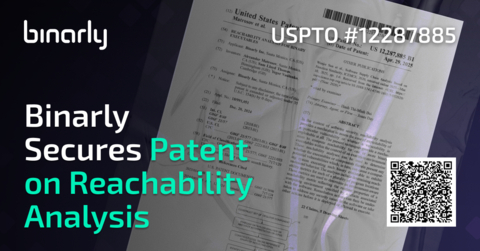Binarly, a leading firmware and software supply chain security company, has been awarded U.S. Patent No. 12,287,885 for its invention of a new method for computing context-sensitive reachability analysis metrics across binary executables.
This press release features multimedia. View the full release here: https://www.businesswire.com/news/home/20250514128562/en/

The patented invention empowers security teams to determine not only whether a vulnerability exists, but how easily it could be exploited in a given real-world environment. Read the full patent (PDF).
The reachability analysis technology has already been fitted into the company’s flagship Binarly Transparency Platform and is currently running at scale across global enterprise deployments.
As documented in this whitepaper, the patented techniques decompose one or more binary executables (or containers of executables) into their constituent components and associated configuration artifacts. For each component, Binarly’s new method constructs inter-procedural control-flow graphs (ICFGs) and code cross-reference graphs, identifies entry points, and computes reachability metrics for every program location.
Crucially, the innovation extends traditional static analysis by integrating context-aware reachability: it factors in real-world runtime properties (loaded libraries, boot scripts, or container entry-point configurations) to produce a reachability metric that reflects how the software actually runs in production.
While existing vulnerability scanners flag potential security flaws without discriminating whether those flaws can ever be reached during execution, Binarly’s patented solution advances the field by:
- Quantifying Exploitability: Assigning metrics to code paths that gauge the difficulty of navigating from a valid entry point to a vulnerable instruction.
- Environment Contextualization: Incorporating runtime artifacts (e.g., init scripts, container manifests, file-system permissions) to refine which code paths are truly viable in a target deployment.
- Joint and Inter-Component Analysis: Extending reachability computations across multiple executables or libraries, revealing cross-binary vulnerabilities that static tools often miss.
“Understanding if and how a vulnerability can be reached in a real environment is a critical part of sharp, actionable cybersecurity,” said Alexander Matrosov, Binarly founder and one of the patent’s inventors. “This patent solidifies our breakthrough approach: moving beyond static vulnerability counts and toward a risk-centric, context-aware reasoning model that aligns remediation efforts with real-world exploitability.”
Binarly has publicly documented its approach to reachability analysis in this white paper.
The Binarly research team has separately secured US patents for CBOM generation from binaries (U.S. Patent No. 12153686) and a machine learning technique to optimize large-scale binary analysis (U.S. Patent No. 12236262).
About Binarly
Binarly is a U.S.-based firmware and software supply chain security company founded in 2021. The flagship Binarly Transparency Platform helps device manufacturers, OEMs and enterprise product security teams to detect vulnerabilities, misconfigurations, secrets, and malicious code in devices and software supply chains. Leveraging decades of research and program analysis expertise, we secure businesses, critical infrastructure, and consumers, while also assisting organizations in transitioning to a post-quantum cryptography (PQC) environment. For more information, visit https://binarly.io.
View source version on businesswire.com: https://www.businesswire.com/news/home/20250514128562/en/
The patented invention determines not only whether a vulnerability exists, but how easily it could be exploited in a given real world environment.
Contacts
Media Contact:
Tyler King
tyler@binarly.io
818-351-9637
